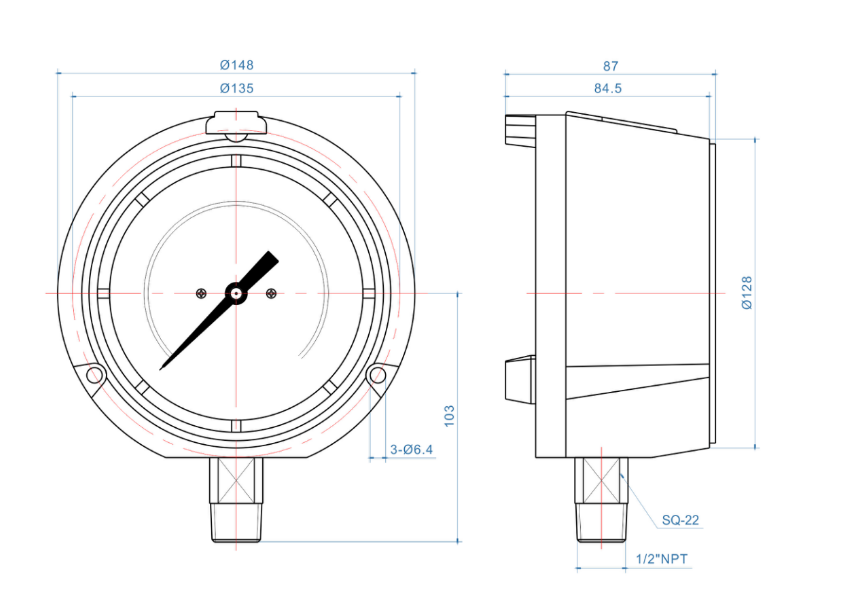
يوليو . 20, 2024 01:20 Back to list
Comprehensive Guide to Square Root Differential Pressure Gauge Solutions and Their Applications
Understanding Square Root Differential Pressure Gauge Products
Differential pressure gauges are vital instruments in various industrial applications, providing crucial measurements that help ensure process efficiency, safety, and reliability. Among the various types of differential pressure gauges, square root differential pressure gauges hold a significant position due to their specific design and functionality. This article delves into square root differential pressure gauge products, their workings, applications, and advantages.
What are Square Root Differential Pressure Gauges?
A square root differential pressure gauge is designed to measure the pressure difference between two points in a system. However, these gauges offer a unique advantage they provide a direct reading that is proportional to the square root of the differential pressure. This characteristic makes them especially useful in flow measurement applications, where the flow rate is proportional to the square root of the differential pressure.
For instance, in a typical flow application involving a flow measurement device like an orifice plate, the flow rate (Q) can be related to the differential pressure (ΔP) across the device by the equation Q ∝ √ΔP. Hence, a square root gauge simplifies this measurement by allowing for direct flow readings without the need for additional calculations.
How They Work
Square root differential pressure gauges work by employing a specially designed diaphragm or a differential pressure sensor that converts the applied pressure difference into an electrical signal. This signal is then processed to yield a reading that is directly proportional to the square root of the input pressure differential.
Most square root gauges utilize digital displays and may feature advanced calibration options. They often incorporate microprocessors that allow for real-time data processing and can communicate with other systems for improved monitoring and control.
Applications
Square root differential pressure gauges find extensive use across various industries, including
1. Oil and Gas These gauges are critical for monitoring flow rates in pipelines and processing units, ensuring safe and efficient operation.
square root differential pressure gauge products

3. HVAC Systems In heating, ventilation, and air conditioning applications, square root differential pressure gauges help maintain optimal airflow and pressure conditions.
4. Pharmaceuticals Precise flow measurements are critical in producing safe medications and ensuring compliance with regulatory standards.
5. Chemical Processing These gauges assist in monitoring the flow of reactants and products, which is essential for maintaining chemical reactions and process safety.
Advantages of Square Root Differential Pressure Gauges
1. Accuracy By providing flow readings directly proportional to the square root of the differential pressure, these gauges enhance accuracy in flow measurements.
2. Simplicity Users can easily interpret flow rates without needing complex calculations, making operations more efficient.
3. Adaptability Square root differential pressure gauges can be calibrated for various applications, allowing for versatility across different industries.
4. Durability Constructed from robust materials, these gauges can withstand harsh operating environments, ensuring long-lasting performance.
5. Real-Time Monitoring Modern square root gauges equipped with digital displays and communication capabilities allow for continuous monitoring and data logging, which is vital for process optimization.
Conclusion
Square root differential pressure gauges are indispensable tools across multiple industries, simplifying the measurement of flow rates and enhancing operational efficiency. Their ability to provide direct readings while being easy to use and reliable makes them a preferred choice in applications requiring precision measurement. As technology advances, we can anticipate even more innovative features and enhancements in square root differential pressure gauge products, further solidifying their role in industrial processes. Whether in gas, liquid, or vapor systems, these gauges are a cornerstone of effective process management and safety assurance.
-
High-Precision 5 Valve Manifold Differential Pressure Gauge Suppliers
NewsApr.29,2025
-
High-Precision Diaphragm Vacuum Pressure Gauges Manufacturers & Quotes
NewsApr.29,2025
-
Omega Differential Pressure Gauges High Accuracy & Durability
NewsApr.28,2025
-
Low Pressure Differential Pressure Gauges Precision Solutions & Quotes
NewsApr.28,2025
-
Digital Diaphragm Pressure Gaauge Precision Measurement & OEM Quotes
NewsApr.28,2025
-
Differential Pressure Gauge China Price High-Accuracy & Best Quotes
NewsApr.28,2025
